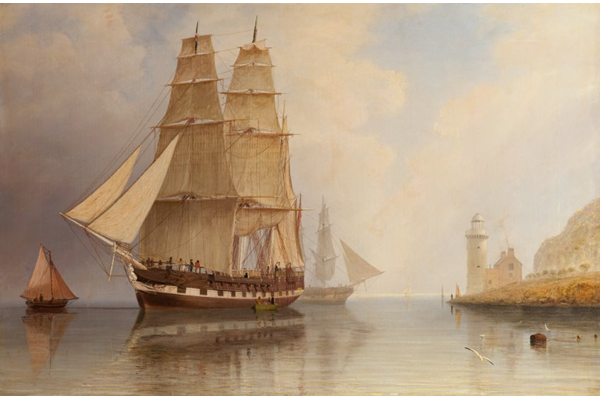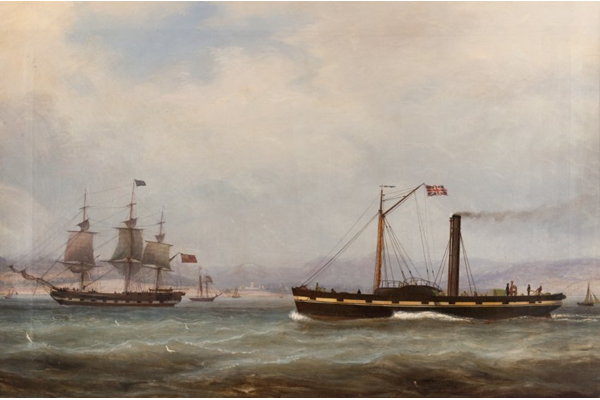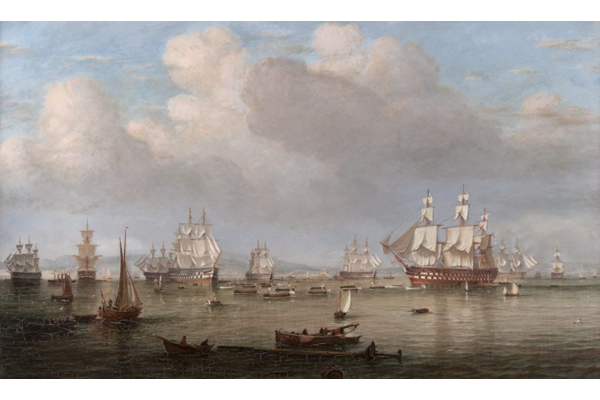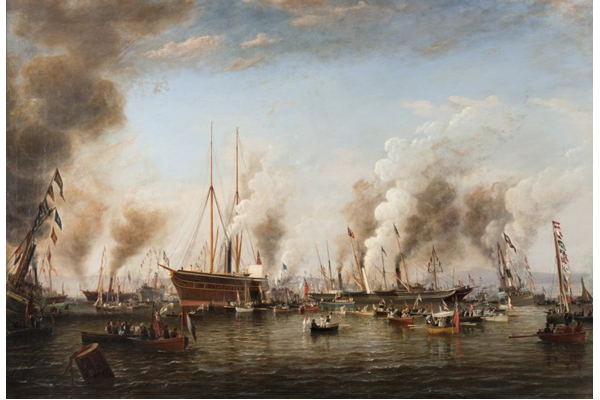William Clark (1803-1883)
Clark was born in Greenock on 26 June 1803, the third child of a mariner, John Clark and his wife Mary. His father later became a customs officer and the young William Clark was apprenticed as a 'decorative house painter'. According to Williamson in his 'Old Greenock', Clark was a pupil of an artist called James Stuart who had a studio in Galbraith's Land, Innerkip Street and he may also have had some lessons from a professional painter but there is no evidence.
An encouragement towards an artistic career would have been the work of Robert Salmon (c 1775- c 1851) who worked in Greenock from 1811 until 1822. It is unknown if Salmon and Clark ever met, but Clark was probably familiar with his work. It is much more likely that William Clark met with John Fleming (1794-1845) who worked in Greenock until his death in 1845.
By the late 1820s Clark was confident enough to set himself up as a professional marine artist on 1st March 1830. The choice of marine artist may have been, consciously or unconsciously, influenced by two factors. The already established John Fleming concentrated on portraits and landscapes rather than marine work and in 1828 Robert Salmon had emigrated to the USA, thus leaving room for a professional marine artist in the town.
Throughout the 1830s he was a regular exhibitor with the Glasgow Dilettanti Society and in 1835 he was asked to paint a picture of the 1835 Regatta for the Royal Northern Yacht Club. An acknowledgement of Clark’s increasing eminence, it was followed by his election to the Royal Northern Yacht Club in 1838. Clark began to exhibit widely and throughout the 1840s he regularly exhibited his work at the exhibitions of the West of Scotland Academy in Glasgow.
In the 1840s Clark’s work continued to develop in sophistication producing masterworks such as 'The Queen’s Visit to the Clyde in 1847'. As the Clyde shipyards moved from the production of sailing ships to steam powered vessels Clark showed himself equally adept at painting both. The popularity of Clark’s work led to many lithographic prints of his paintings.
His growing reputation and increasing prosperity can be seen in the addresses of his residences. In the 1830s he was living at 9 William Street but by 1841 he had moved to Cross Shore Street, where he lived at various numbers until 1857 when he moved to No.2 Fox Street, Greenock where he was to remain until his death.
In his latter years Clark was able to afford his own house and pay for a housekeeper and a housemaid. He was fortunate to live during the heyday of Clyde shipbuilding when commissions from owners and masters ensured a steady supply of work, enabling Clark to spend his career in his native town without having to seek patrons elsewhere. Clark did not exhibit during the last twelve years of his life and he seems to have painted infrequently due to poor health. He died on the 10 November 1883 from a cold which developed complications.
The Glasgow Herald of 12 November 1883 was fulsome in its praise of Clark’s work: 'In this department of art Mr. Clark had few rivals, and nearly every celebrated Clyde-built ship and latterly many famous steamers have been represented by him. Occasionally his art would take a higher flight, and in several pictures of a more general character he was highly successful…Many stirring scenes, such as the Channel Fleet off Greenock, and other memorable incidents at the Tail of the Bank, also secured his attention, while all along the West Coast familiar attractive spots have been interwoven with his marine subjects. His ships were drawn with mathematical precision, every detail connected with hull, rigging, etc. being minutely reproduced…A few days ago Mr. Clark caught cold, which rapidly developed into a bronchial complication from which he failed to rally.’
The Greenock Advertiser’s obituary of 12 November 1883 perhaps provides the best summation of Clark’s art: 'Besides showing much fidelity to details in drawing, he displayed very considerable artistic feeling in the manner in which he handled his subjects’.
To get a print or license the use of any of these images please contact the Art UK shop. If you have any other questions concerning this collection please contact us at wattinstitution@inverclyde.gov.uk.

The barque Kilblain becalmed off the Cloch lighthouse by William Clark (1803-1833)
The barque Kilblain becalmed off the Cloch lighthouse by William Clark (1803-1883) - Oil on canvas - 60.4 x 91.2 cm - 1995.1 ©McLean Museum and Art Gallery, Greenock.

The Tug Conqueror by William Clark (1803-1883)
The Tug Conqueror by William Clark (1803-1883) - Oil on canvas - 58.5 x 89 cm - 1840s - 1977.710 ©McLean Museum and Art Gallery, Greenock.

The barque Eldon off Ailsa Craig by William Clark (1803-1883)
The barque Eldon off Ailsa Craig by William Clark (1803-1883) - Oil on panel - 38.3 x 56 cm - 1831 - 1977.712 ©McLean Museum and Art Gallery, Greenock.

The Channel Fleet off Greenock, 27 August 1861 by William Clark (1803-1883)
The Channel Fleet off Greenock, 27 August 1861 by William Clark (1803-1883) - Oil on canvas - 64.5 x 110.4 cm - 1861 - 1977.711 ©McLean Museum and Art Gallery, Greenock.

The Queen's Visit to the Clyde, 17 August 1847 by William Clark (1803-1883)
The Queen's Visit to the Clyde, 17 August 1847 by William Clark (1803-1883) - Oil on canvas - 77 x 112.5 cm - 1847 - 1977.713 ©McLean Museum and Art Gallery, Greenock.




